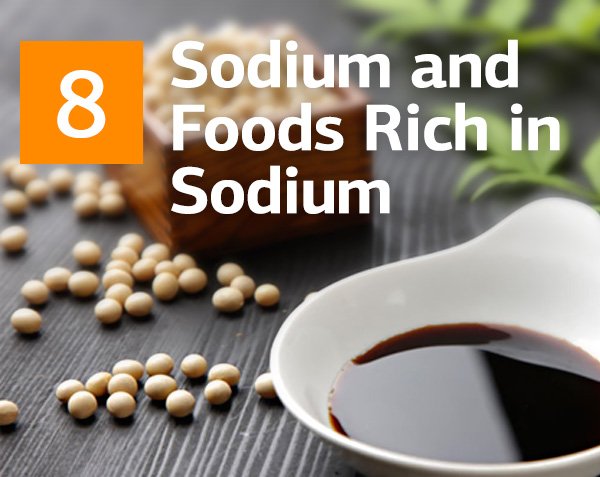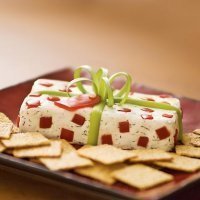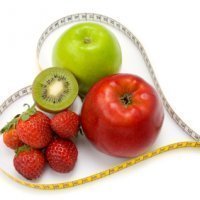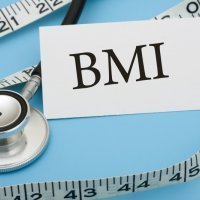Sodium and 8 Foods Rich in Sodium That Are OK
Sodium was first educed in 1807 by the British chemist Sir Humphry Davy. It belongs to the group of metals and has silver color, which quickly disappears in air. As a chemical element, sodium is very reactive, that’s why it is rarely found in pure form. Interestingly, sodium is present in absolutely all the animals and plants in the nature.
A body of an adult contains around 90 grams of sodium. It regulates the acidity of human blood, holds liquid in the body and takes part in the regulation of blood flow. It also is a necessary element in the digestive process, because it participates in formation of digestive juices. Sodium plays an important role in regulation of blood pressure and muscular contractions, as well as maintenance of normal heartbeat. It also contributes to the resiliency of body tissues. This element is very important for the excretory system of a human body and also helps to regulate the transfer of substances between cells.
Interesting fact! Carnivorous animals get enough salt, because it is contained in their food. Herbivorous animals usually are in short supply of this element that is why they like to lick pure salt or... sweaty human hands!
Most of the natural food products contain sodium. This element significantly improves food taste. Since it is a widespread element, it is almost impossible to get its deficiency in normal conditions and with sufficient nutrition.
Sodium consumption should be increased in case of intensive muscular load under high temperature of environment (in hot climate, etc.), after massive burns, during intense vomiting and diarrhea, deficient function of adrenal glands and extensive consumption of plant products (which contain potassium, the natural antagonist of sodium). If the sodium loss is not compensated, it may lead to hyponatremia, accompanied by dehydration of organism. It causes immense thirst, which can only be satisfied by drinking salted water. Dehydrated skin becomes dry and quickly looses tonus. The dehydration may get to the point, when skin becomes slack and wrinkled, and eyes sink into skull. Hyponatremia affects functioning of the digestive system (loss of appetite, nausea, vomiting), cardiovascular system, kidneys. Unlike the deficiency of sodium, its overconsumption happens more often.
Excessive consumption of sodium induces inflammatory and allergic reactions. The symptoms of sodium oversupply are as follows: fluid retention in the body, hyper excitability, cramps, increase of body temperature, etc. If a person has problems with kidneys or suffers from cirrhosis, the retention of fluid can be enormously high and dangerous.
The daily norm of sodium consumption is 4-6 g, which equals to 10-15 g of table salt. This amount of salt can be taken safely by a healthy person, although it seriously exceeds physiological needs and can be lowered up to 5 g of salt per day. At the same time, the genuine sodium deficiency (salt hunger) is very hard to endure.
The most popular and widespread sodium source is, of course, regular table salt. Apart from this source, there are many others, for example:
1. Soya Sauce
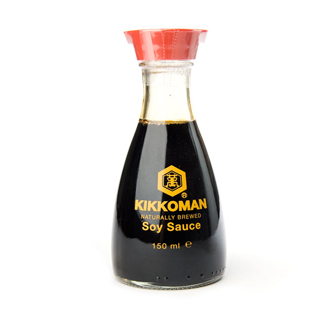
| Soy Sauce Made From Soy (tamari) | |
| 100 g | 1 tbsp (18 g) |
| Sodium: 5586 mg (233% DV) |
Sodium: 1005 mg (42% DV) |
Soya sauce – a healthy substitute of salt, which also contains an enormous quantity of vitamins. In Asian cuisine, this product is nearly worshipped, and with a good reason! Soya sauce is a perfect source of vitamins and minerals, but its main benefit lies in its high amino acids level. In terms of their effectiveness, soya sauce exceeds all the citrus fruit, enriched with vitamin C, by 150 times! Moreover, it gives food an interesting delicate flavor.
2. Fish
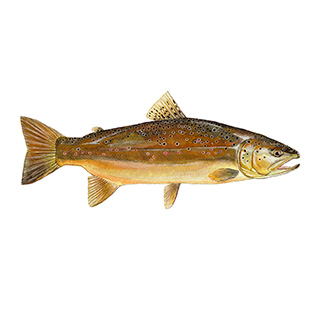 Types of Fish Rich in Sodium (100g):
Types of Fish Rich in Sodium (100g):
| Cod, Pacific | |
| 100 g | 1 fillet (116 g) |
| Sodium: 303 mg (13% DV) |
Sodium: 351 mg (15% DV) |
Fish, especially fatty sea fish. This is a remarkable natural source of digestible sodium. Sea fish is also beneficial due to its high level of healthy fats and liposoluble vitamins. Fish is also a perfect source of protein, the main building material for our body!
3. Laminaria
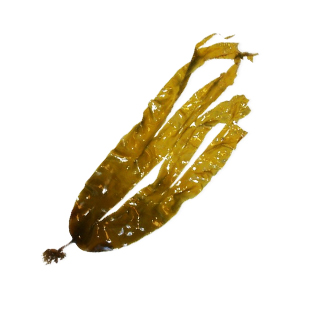
| Seaweed, Kelp | |
| 100 g | 2 tbsp (10 g) |
| Sodium: 233 mg (10% DV) |
Sodium: 23 mg (1% DV) |
According to the ancient Chinese legend, laminaria is a source of enormous stamina and power, the main ingredient of the holy nectar. Apart from sodium, this seaweed contains iodine, magnesium, iron and many other chemical elements. In a word, laminaria is a perfectly balanced natural complex, including almost forty vitamins, micro- and macroelements. And it's tasty!
4. Prawns
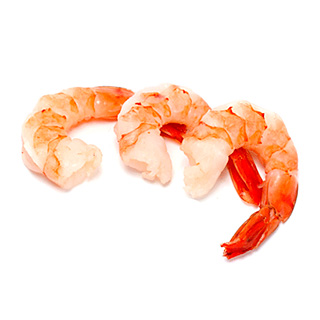
| Crustaceans, Shrimp, Mixed Species | |
| 100 g | 1 medium (6 g) |
| Sodium: 566 mg (24% DV) |
Sodium: 34 mg (1% DV) |
Prawns – they are a dietary source of sodium and lean protein, and also contain all the indispensable amino acids. Prawns give you a lot of iodine, which is necessary for production of thyroid hormones, which regulate the metabolism. Also prawns contain all the liposoluble vitamins: К, А, Е, and D.
5. Cheese
 Types of Cheese Rich in Sodium (100g):
Types of Cheese Rich in Sodium (100g):
| Cheese, Roquefort | |
| 100 g | 1 oz (28 g) |
| Sodium: 1809 mg (75% DV) |
Sodium: 513 mg (21% DV) |
Cheese – this is a product which not only is guaranteed to give you the necessary quantity of sodium, but will also raise your mood, because it stimulates the production of serotonin – the hormone of happiness! Although cheese is a very wholesome product, one shouldn't eat more than 30-40 g of it per day to avoid gaining weight and getting too much salt.
6. Sausages, Ham
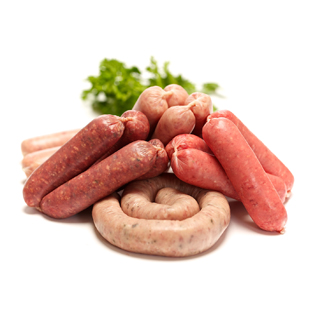 Types of Sausages, Ham Rich in Sodium (100g):
Types of Sausages, Ham Rich in Sodium (100g):
| Sausage, Berliner, Pork, Beef | |
| 100 g | 1 oz (28 g) |
| Sodium: 1297 mg (54% DV) |
Sodium: 368 mg (15% DV) |
| Pork, Cured, Ham, Whole, Separable Lean Only, Unheated | |
| Sodium: 1516 mg (63% DV) |
Sodium: 430 mg (18% DV) |
Sausages, ham – a not-so-dietary choice for quick raise of sodium level of your body. It is recommended to select the products made of high quality meat with minimal thermal conditioning and fattiness.
7. Bread
 Types of Bread Rich in Sodium (100g):
Types of Bread Rich in Sodium (100g):
| Bread, Cheese | |
| 100 g | 1 slice (48 g) |
| Sodium: 750 mg (31% DV) |
Sodium: 360 mg (15% DV) |
Any bread will quickly solve the problem of sodium deficiency, but whole meal bread is the best for your health! It is a perfect choice for people, who watch their health and want to stay fit.
8. Pickles
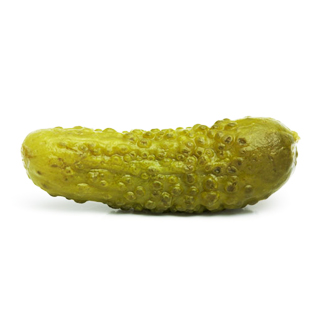 Types of Pickles Rich in Sodium (100g):
Types of Pickles Rich in Sodium (100g):
| Pickles, Cucumber, Sour | |
| 100 g | 1 medium (3-3/4 inch long) (65 g) |
| Sodium: 1208 mg (50% DV) |
Sodium: 785 mg (33% DV) |
Pickles are the other source of sodium. Unlike fresh vegetables, salted ones contain a lot of salt. If you prepare pickles by yourself, limit the amount of salt in the marinade. If you buy ready-made pickles, read the label and make sure salt is not on the top of the list of ingredients.
All in all, it is not hard to figure out that the foods that are highest in sodium are all the sea products and the products, which are prepared with a big quantity of salt. Such food will do well for hypotensive people by helping to normalize their blood pressure. On the contrary, people with elevated pressure must avoid salty food at all times, as it may be very harmful for their condition. People with normal pressure and healthy kidneys are recommended to follow the measure in salty food and watch their state of health. All people without exception must avoid eating fast food, because it contains an enormous quantity of sodium, which may have a big negative impact on the body. Children usually tend to eat a lot of salty food, for example, chips. Even though it is not recommended, if the child is healthy, reasonable amount of junk food will not do much harm. On the other side, eating habits accompany us into adult life that is why it is better to get used to healthy food from childhood.
The negative influence of sodium may be greatly smoothed away by eating the products, high in potassium: dried fruits, potatoes, beans, peaches, oatmeal etc. – overweight and elderly people need to consider this fact. In general, low-salt diets are considered to be very beneficial for health. To “wash out” the unnecessary salt from your body, you can drink a lot of pure water, do exercise (especially aerobic) or use natural diuretics (coffee, green tea, watermelon etc.). But be careful! All these measures of self-treatment are restricted during the hypernatremia or hyponatremia (high and low concentration of sodium in blood). If you have these symptoms, you should consult a doctor.
